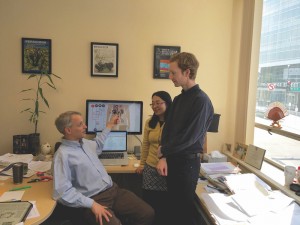Sometimes, when scientists apply the knowledge and methods of one discipline to another, surprising and novel discoveries can manifest. Questions such as “How did each case of cancer come to be?” may benefit from an additional perspective, complementing that of a traditional oncologist. A team led by Yale University professor Jeff Townsend utilized techniques from the fields of evolutionary biology and bioinformatics to explore this question through a new lens. Earlier in 2016, their research was published in the Proceedings of the National Academy of Sciences, providing new evidence that the development of cancer in an individual’s body can be thought of as an evolutionary process. This insight has the potential to inform the development of more efficient treatments for cancer.
One of the reasons why cancers are so difficult to understand and treat is that they can change rapidly within a patient’s body, garnering new mutations and properties over time. Metastasis—the spread and migration of cancerous cells to various parts of the body—is perhaps the most critical determining factor for the survival rate of cancer patients. In order to better understand how these types of cells develop, Zi-Ming Zhao, postdoctoral associate and lead author of the paper, worked with her fellow scientists to unravel the connections between different cancer cell lineages in a patient’s body.
Townsend and collaborators in Yale’s genetics, pathology, and pharmacology departments had generated an immense wealth of genome sequencing data from cancer patients. The team constructed evolutionary trees to pinpoint when known cancer-linked mutations are likely to occur. They found that some mutations occurring in the early stages of cancer development—near the root of the evolutionary tree—can promote metastasis later on. Over time, different series of mutations can lead to a variety of paths along which cancer evolves and diversifies within a patient.
“These evolutionary techniques were traditionally applied to multiple species, but we applied them to multiple independent tumor tissues that all evolved from normal tissue,” Townsend said. Previous studies had compared normal tissues to primary tumors, but Zhao said that the Yale-based study took this analysis one step further by comparing the various metastatic tissue lineages. The team also was able to find subtle distinctions between tissues from the same tumor, by comparing sequencing data from a myriad of genes. The team’s success further underscores the heterogeneity of cancer cells.
Applying an evolutionary lens to oncology not only enhances scientists’ understanding of how cancers come to be and how they develop, but also improves how treatments for actual patients are developed and administered. “It is not just an evolutionary model or cancer data; it is also about how a patient can be treated, [and] how we can maintain their lives,” Zhao said.
Townsend emphasized that the ability to predict the likely ways that cancer evolves in the body would be a powerful tool for researchers. Knowing which early-stage mutations drive metastasis would allow scientists to target these key factors from the beginning. “There is diversity within the disease, and we have to think very carefully and adaptively about how we treat patients with cancer, so as to make sure we target every part of the cancer that [they] have,” he added.
Looking forward, the Townsend lab will build upon their research by looking at “longitudinal data,” tracking the development of cancers in patients from their diagnosis onward. As it stands, this study is helping to set a precedent in the realm of basic research: it is a testament to the power of an interdisciplinary approach and the utility of massive data sets.

